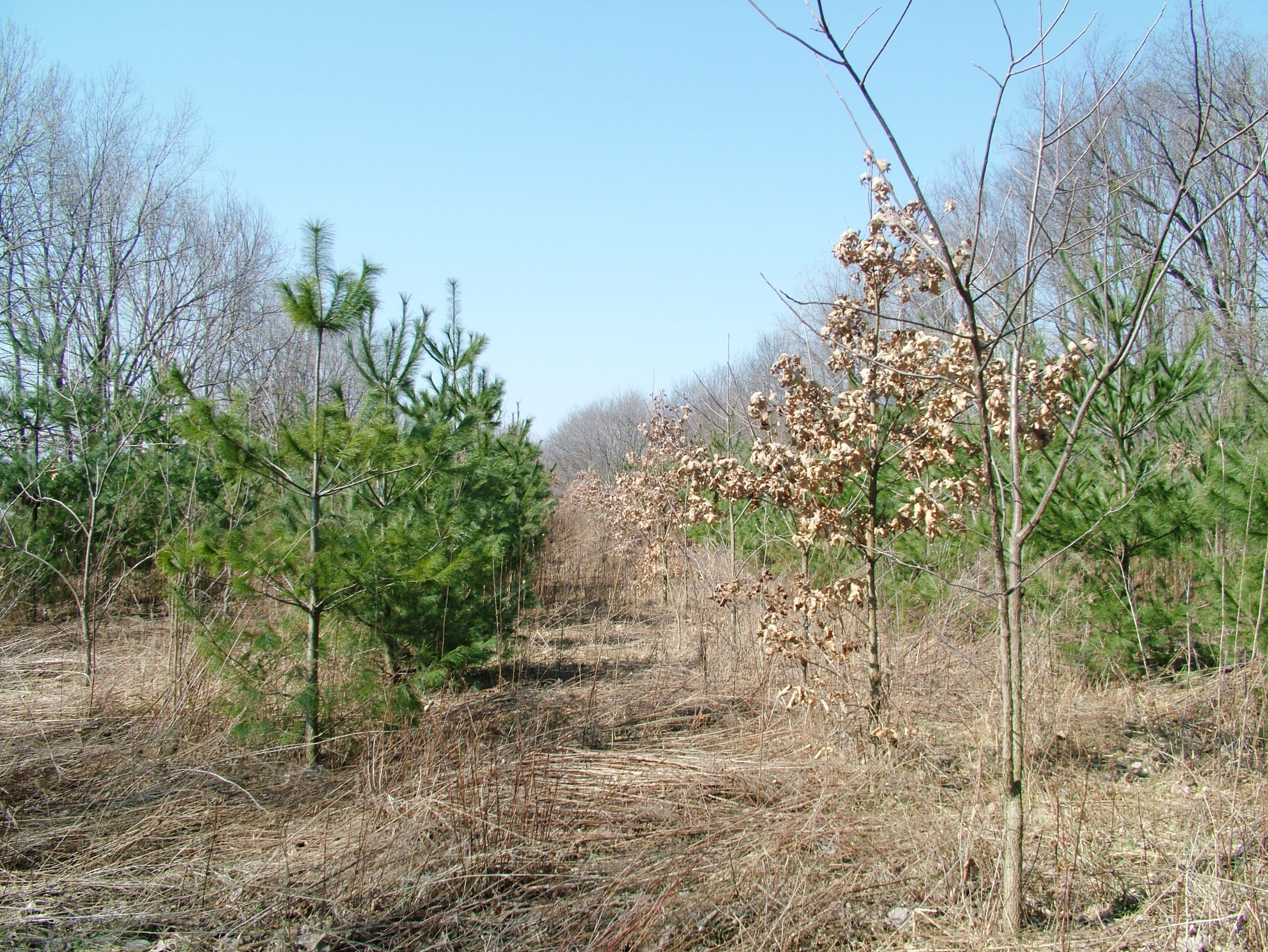Thinning Mixed Hardwood Plantings
 Figure 2. Older mixed hardwood stand (photo by Ron Rathfon).By Bruce Wakeland ACF, CF
Figure 2. Older mixed hardwood stand (photo by Ron Rathfon).By Bruce Wakeland ACF, CF
The Conservation Reserve Program (CRP) became available in the spring of 1987 for planting hardwood trees on erosive crop land. The financial incentives offered by the CRP for tree planting were very good, which resulted in millions of hardwood trees being planted across Indiana. The best years were 1987 through 2007, during which time my business, Wakeland Forestry Consultants, planted over 500,000 trees nearly every year. All of that planting has resulted in a lot of acres of trees that are due for, or will at some time need, thinning.
The first benefit of a tree thinning is to improve the timber quality of a stand by favoring the better trees and ensuring that they will be the winners. This can greatly increase the future value of a stand of timber. The second benefit of a thinning is to allow those released trees to grow at a faster rate thereby shortening the years until harvest.
Nearly all of the tree plantings we do are on an 8 by 8 foot spacing. After access lanes and other obstacles are allowed for, the average number of trees planted per acre is 600. We only have room to grow about 40 crop trees per acre to economic maturity. So why plant 600 trees to get just 40? We need the closer spacings to create crown closure as soon as possible to help convert the site from an old field environment to a cool moist woodland environment, which improves tree growth rates. Closer spacings allows us to mix four to eight different tree species together, giving us the best chance of having the right species planted, even though soils are variable across the site. A mix of tree species gives us some protection from insect and disease problems, as well as changes in future timber markets and ownership objectives. The larger number of trees per acre also allows for competition among trees that forces them to grow straight, tall, and clear of lower branches. All of these advantages have to be balanced against the cost of thinning, and the need for the crop trees to have room to grow at a fast rate.
The timing of a thinning is important. If we wait too long, the growth rate of the crop trees slows way down. Trees with small crowns become stressed and more vulnerable to attack by insect and diseases. The higher value trees, such as walnut, can become so overtopped by less desirable trees that we might lose them as possible crop trees. If thinning is overdue, possible crop trees can become tall and spindly; then when they are released, they cannot support their own top, and they droop over and become useless as crop trees. If thinning is done too soon, it is hard to determine which will become the best crop trees, the cost of management is increased by creating an unnecessary thinning, and the benefits derived from the closer spacing in a young planting are reduced. We do the first thinning in most of the plantings we work with between ages twelve and fifteen. This is what we call a pre-commercial thinning, meaning we cannot sell the trees we are killing.
For pre-commercial thinning, trees selected for removal are killed by cutting them down or by ringing them with a chainsaw and squirting a small amount of undiluted glyphosate in the cut, the latter is usually less costly. We leave all dead trees where they lie to reduce costs, to slow down deer movements, to reduce damage to crop trees, and to contribute to nutrient recycling.
We have done several thousand acres of these thinnings over the last 15 years, and I have found that there is a lot of variability from one planting to the next, which is why I thin using crop tree release as my guiding principle. I look for a good crop tree on what would average out to a 20 by 20 foot spacing and kill trees to make sure the crop tree has room to grow its crown on three sides. That works out to 100 released crop trees per acre. A planting with 100 crop trees per acre is ready for an income producing commercial thinning when the crop trees average 14” DBH, which takes about 32 to 35 years on most sites in northern Indiana. Figure 1. Young mixed hardwood plantation (photo by Lenny Farlee). The pines are planted in alternate rows and will be cut out in a thinning.
Figure 1. Young mixed hardwood plantation (photo by Lenny Farlee). The pines are planted in alternate rows and will be cut out in a thinning.
By the time of the second precommercial thinning these mixed hardwood plantings have mostly lost their plantation like nature and have an understory of native woodland plants and natural regeneration. We manage them with the idea that we have a forest and will not need or want to have a clear-cut type harvest and start over like they do in some timber types. We try to design tree plantings so that there is need for only one precommercial thinning, but it is common to need two precommercial thinnings because we do not have pulp, pole, or chip markets in our work area.
Over the years we have planted many hardwood and white pine mixtures, using the pine as a nurse crop. In most cases the pine are overtopped by the hardwoods by year 20 and do not need to be thinned from the stand. Sometimes, usually the result of deer browse, the pine will overtop more desirable hardwoods and need to be thinned from the planting. Figure 3. This plantation has been thinned, as evidenced by the gaps between trees, but is in need of additional thinning.
Figure 3. This plantation has been thinned, as evidenced by the gaps between trees, but is in need of additional thinning.
Thinning often includes dealing with many naturally regenerated trees along with the planted trees. We sometimes select these trees as crop trees. Knowing which trees to select as crop trees requires a strong knowledge of the site, local timber markets, ownership objectives, silviculture, and some good guess work about future markets and risk factors to trees.
Bruce Wakeland is a consultant forester with 43 years of professional experience in Indiana
